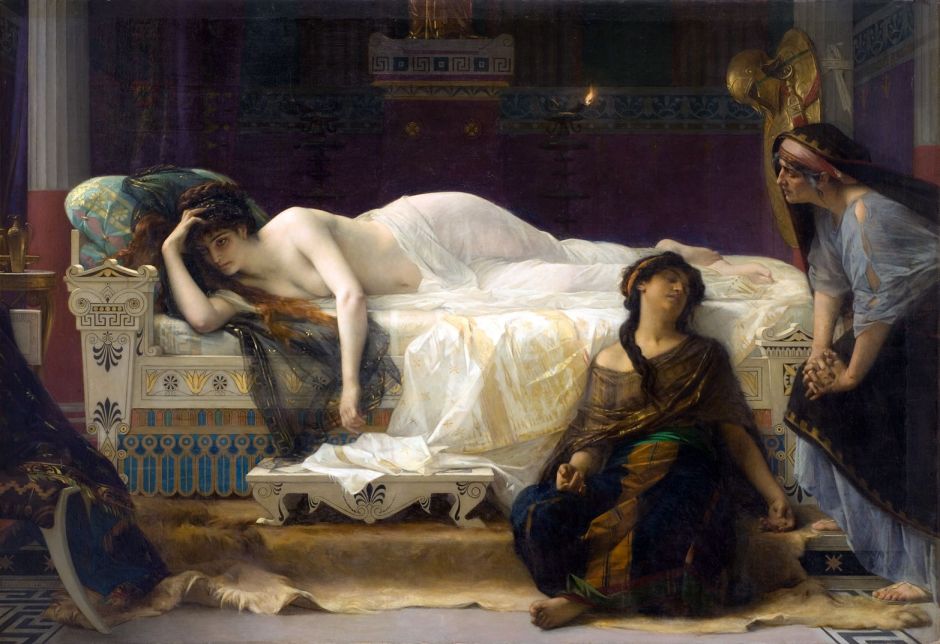In my first article celebrating the bicentenary of the birth of the French painter Alexandre Cabanel, I ended with a painting of his from shortly after he had been appointed a professor at the École des Beaux-Arts in Paris in 1864. For the rest of his career, his major commitment was to his pupils, and to maintaining the standards and traditions of the annual Salon in Paris.

Completed just before the war which brought the Second Empire to its close, The Deaths of Francesca da Rimini and Paolo Malatesta (1870) tells the story from Dante’s Divine Comedy (Inferno, Canto V) of the adulterous affair between Francesca and her younger brother-in-law. After ten years, Francesca’s husband Giovanni caught them together, and killed them both. Giovanni is seen lurking in the shadows at the right. This scene had been painted by JAD Ingres in 1819, and by Delacroix in 1825. Athough the ‘whirlwind’ motif from Inferno had generally been more popular, this became at least as prevalent in the nineteenth century. Cabanel here shows the fine detail that you might have expected to see in a depiction by Gérôme, who was just a year younger than Cabanel.

Cabanel’s early portraits seemed rather ordinary, but by this time he was apparently sought after, particularly by affluent American wives, who were prepared to travel to Paris to be painted by him. This portrait of the Swedish soprano Christine Nilsson shows her as Pandora (1873), and is clearly not intended as an account of the myth.

The Daughter of Jephthah (1879) is an unusual motif that he painted three years after his pupil Édouard Debat-Ponsan. In this story from the Old Testament, Jephthah vowed to sacrifice to God the first object or creature which he saw on his return from victory over the Ammonites. This turned out to be his daughter. Realising her fate was inevitable, she successfully pleaded for two months’ grace, during which she went up into the mountains “to weep for her virginity”. Both Debat-Ponsan and Cabanel opted unusually to depict Jephthah’s daughter during those last months in the mountains, although their treatment and composition are quite different.

In his late career, he seems to have concentrated on the theme of the doomed woman: this next painting shows the tragic figure of Phaedra (1880), who fell helplessly in love with her step-son. When he rejected her advances, she told her husband Theseus (father of the young man) that he had raped her. Theseus cursed his son, who was then dragged to death by his horses. Surprisingly, when it was exhibited at the Salon of 1880, it attracted adverse criticism.

Ophelia had long been a popular character from Shakespeare’s play Hamlet to depict on canvas. Cabanel’s painting of her from 1883 shows her moments before she drowns, propped against a broken limb of a tree. This scene had been painted most famously by John Everett Millais in 1851-52, a work that Cabanel would undoubtedly have seen. However, he may not have been aware that one of his most successful former pupils, Jules Bastien-Lepage, had started to paint her two years earlier, but that work remained incomplete when Bastien-Lepage died in 1884.

Cabanel painted the story of Rebecca and Eliezer in 1883. According to the account in Genesis chapter 24, Abraham wanted to find a wife for his son Isaac, so sent his servant Eliezer back to the homeland of Mesopotamia to look for one. Eliezer reached the city of Nahor, where he stopped to water his camels and rest from his long journey. He pulled up at a well outside the city, where a young woman, Rebecca, had just drawn water. She offered him that, leading him to recognise her as Isaac’s chosen bride and to present her with the betrothal gifts he had brought with him. Although this painting has seen better days, and I hope has now undergone conservation work, it still has an almost magical light, and rich details.

Just a couple of years before his death in 1889, Cabanel found another tragic heroine in Cleopatra Testing Poisons on Condemned Prisoners (1887). Known for her ruthless pursuit of power and her alleged beauty, Cleopatra spent much of her life as co-ruler of Egypt with one of her brothers, including Ptolemy XIV. A few months after the assassination of Julius Caesar in Rome, in 44 BCE, Cleopatra had returned to Egypt, where she had her brother killed by poison, making her co-ruler her son by Caesar, Caesarion. It’s likely that this painting refers to an apocryphal story that Cleopatra had candidate poisons tested out on prisoners to help her select the one to be used to kill her younger brother.
By this time, Cabanel’s persistent opposition to Manet and the Impressionists had failed, and his academic style had fallen from favour even at the Salon. The critics were more laudatory of his Cleopatra, though.
Cabanel remained devoted to teaching until he died in Paris on 23 January 1889. In the third and final article in this series, I will look at his teaching and the paintings of some of his more successful pupils.

